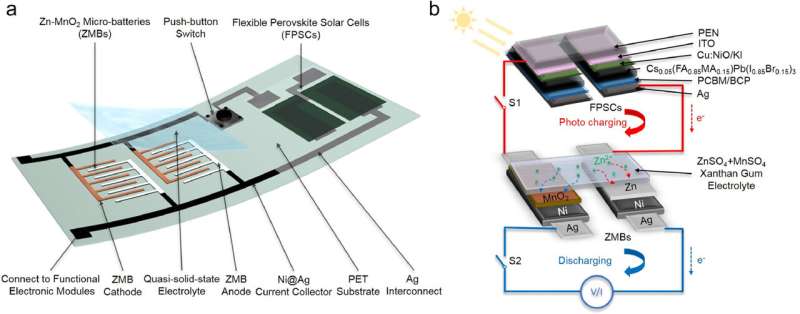
Thirty seconds of sunlight could boost the battery life of future smartwatches and other wearables by tens of minutes, thanks to a renewable and rechargeable battery prototype developed by the University of Surrey.
Surrey’s Advanced Technology Institute (ATI) has demonstrated how its new photo-rechargeable system, which merges zinc-ion batteries with perovskite solar cells, could allow wearables to spring back to life without the need to plug in.
Jinxin Bi, a Ph.D. candidate at ATI and the first author of the paper, says that “this technology provides a promising strategy for efficient use of clean energy and enables wearable electronics to be operated continuously without plug-in charging. Our prototype could represent a step forward to how we interact with wearables and other internet-of-things devices, such as remote real-time health monitors.”
Surrey’s environmentally friendly, photo-rechargeable system is unique because of it’s elegant and well-matched structural design between the integrated battery and solar cell, allowing it to demonstrate high energy and volume density comparable to state-of-the-art micro-batteries and super capacitors.
Dr. Wei Zhang, project co-lead and expert in perovskite solar cells from the ATI, says that “this project is an example of how the University of Surrey is dedicated to producing research and innovation that equips humanity with the knowledge, tools and technologies to help us live better and more sustainable lives.”
Dr. Yunlong Zhao, project co-lead and expert in batteries for wearables and implantables from the ATI, says that “the unique features in our ultrafast photo-rechargeable system could promote wide applications in self-powered wearable internet-of-things, autonomous power systems and emergency electronics. In addition, it will broaden the perception and insight of designing the next generation of miniaturized flexible photo-rechargeable systems.”
The research was published in Energy Storage Materials.
Solving the solar energy storage problem with rechargeable batteries that can convert and store energy at once
Jinxin Bi et al, A Highly integrated flexible photo-rechargeable system based on stable ultrahigh-rate quasi-solid-state zinc-ion micro-batteries and perovskite solar cells, Energy Storage Materials (2022). DOI: 10.1016/j.ensm.2022.06.043
Citation:
Prototype battery only needs seconds of sunlight to keep smart wearables charged (2022, August 3)
retrieved 3 August 2022
from https://techxplore.com/news/2022-08-prototype-battery-seconds-sunlight-smart.html
This document is subject to copyright. Apart from any fair dealing for the purpose of private study or research, no
part may be reproduced without the written permission. The content is provided for information purposes only.
Stay connected with us on social media platform for instant update click here to join our Twitter, & Facebook
We are now on Telegram. Click here to join our channel (@TechiUpdate) and stay updated with the latest Technology headlines.
For all the latest Technology News Click Here
For the latest news and updates, follow us on Google News.
